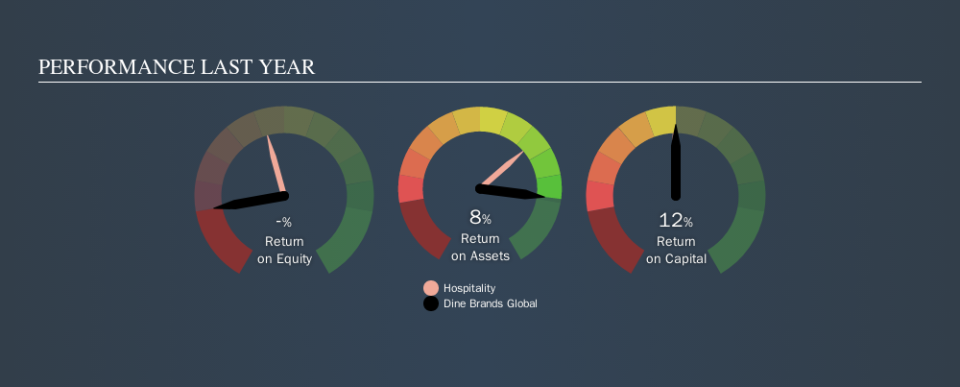What Can We Make Of Dine Brands Global, Inc.’s (NYSE:DIN) High Return On Capital?

Today we are going to look at Dine Brands Global, Inc. (NYSE:DIN) to see whether it might be an attractive investment prospect. To be precise, we'll consider its Return On Capital Employed (ROCE), as that will inform our view of the quality of the business.
Firstly, we'll go over how we calculate ROCE. Second, we'll look at its ROCE compared to similar companies. Last but not least, we'll look at what impact its current liabilities have on its ROCE.
What is Return On Capital Employed (ROCE)?
ROCE measures the amount of pre-tax profits a company can generate from the capital employed in its business. All else being equal, a better business will have a higher ROCE. Ultimately, it is a useful but imperfect metric. Renowned investment researcher Michael Mauboussin has suggested that a high ROCE can indicate that 'one dollar invested in the company generates value of more than one dollar'.
How Do You Calculate Return On Capital Employed?
Analysts use this formula to calculate return on capital employed:
Return on Capital Employed = Earnings Before Interest and Tax (EBIT) ÷ (Total Assets - Current Liabilities)
Or for Dine Brands Global:
0.12 = US$209m ÷ (US$2.0b - US$296m) (Based on the trailing twelve months to June 2019.)
So, Dine Brands Global has an ROCE of 12%.
See our latest analysis for Dine Brands Global
Is Dine Brands Global's ROCE Good?
ROCE can be useful when making comparisons, such as between similar companies. Dine Brands Global's ROCE appears to be substantially greater than the 9.2% average in the Hospitality industry. We consider this a positive sign, because it suggests it uses capital more efficiently than similar companies. Regardless of where Dine Brands Global sits next to its industry, its ROCE in absolute terms appears satisfactory, and this company could be worth a closer look.
The image below shows how Dine Brands Global's ROCE compares to its industry, and you can click it to see more detail on its past growth.
Remember that this metric is backwards looking - it shows what has happened in the past, and does not accurately predict the future. ROCE can be deceptive for cyclical businesses, as returns can look incredible in boom times, and terribly low in downturns. ROCE is only a point-in-time measure. Since the future is so important for investors, you should check out our free report on analyst forecasts for Dine Brands Global.
Dine Brands Global's Current Liabilities And Their Impact On Its ROCE
Current liabilities are short term bills and invoices that need to be paid in 12 months or less. Due to the way the ROCE equation works, having large bills due in the near term can make it look as though a company has less capital employed, and thus a higher ROCE than usual. To counteract this, we check if a company has high current liabilities, relative to its total assets.
Dine Brands Global has total liabilities of US$296m and total assets of US$2.0b. Therefore its current liabilities are equivalent to approximately 15% of its total assets. Low current liabilities are not boosting the ROCE too much.
What We Can Learn From Dine Brands Global's ROCE
With that in mind, Dine Brands Global's ROCE appears pretty good. There might be better investments than Dine Brands Global out there, but you will have to work hard to find them . These promising businesses with rapidly growing earnings might be right up your alley.
If you are like me, then you will not want to miss this free list of growing companies that insiders are buying.
We aim to bring you long-term focused research analysis driven by fundamental data. Note that our analysis may not factor in the latest price-sensitive company announcements or qualitative material.
If you spot an error that warrants correction, please contact the editor at editorial-team@simplywallst.com. This article by Simply Wall St is general in nature. It does not constitute a recommendation to buy or sell any stock, and does not take account of your objectives, or your financial situation. Simply Wall St has no position in the stocks mentioned. Thank you for reading.

